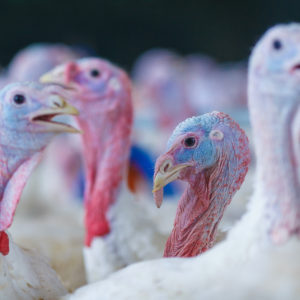Turkeys are synonymous with Thanksgiving. Almost every household celebrating this holiday season is likely to have a turkey on its table. This leads one to wonder where these birds are produced, how they’re raised, the amount we spend on them and whether other countries like turkeys too? We delve into the fascinating realm of the turkey industry.
Turkeys in the USA
Turkeys are indigenous to North America, they’ve been here for centuries, and when Thanksgiving as a holiday started getting popular in the early 20th century, turkeys became the meat of choice because they were locally available and could feed lots of people at the same time. It’s been reported that founding father Alexander Hamilton was also a fan of turkeys and pushed for its inclusion on Thanksgiving.
According to data from the United States Department of Agriculture, America is the world’s biggest producer and exporter of turkeys, with 244 million birds produced in 2016. As of 2016, the U.S. is also the second largest consumer of turkey, eating around 16.6 pounds per person in 2016, second only to Israel. As the Israeli newspaper Haaretz noted earlier this week, “Every day is Thanksgiving for Israelis, who gobble up more turkey than anyone in the world.”
Although turkeys are considered a holiday meal time classic, over the past several decades it has also become a year-round part of the American diet, as people look for less expensive and healthier alternatives to red meat. Retail prices for frozen whole turkeys were $1.55 per pound in 2016.
However according to the USDA’s monthly newsletter Livestock, Dairy, and Poultry Outlook, demand for turkey appears to be going down this year, which has led to prices lowering as well.
Turkey meat production this year in the US is down about 0.5 percent from the same period in 2016 and whole turkey price projections were decreased further as prices have remained below historical averages.
Wholesale whole hen frozen turkey prices also continue to fall below historical averages and are particularly low for the Thanksgiving season, when prices traditionally reach their annual peaks. Hens are female turkeys which usually weigh from 8 to 16 pounds whereas the male turkeys, “Tom turkeys,” usually weigh from 18 to 32 pounds.
The latest price data covering the first week of November shows whole turkey prices at 88 cents per pound, the lowest level this year and the lowest since January 2011. The low wholesale prices are an indication that turkey meat demand has not kept pace with its recent production. For 2018, turkey production projections were lowered 115 million pounds due to weakness in prices.
Turkey Exports
Turkey exports are booming at the moment, with demand for the big birds increasing outside our borders. The USDA reports that the U.S. has exported close to 611 million pounds of turkey meat in 2017 so far, a nine percent rise from last year. Mexico makes up the largest market for U.S. turkey meat, accounting for more than 50 percent of exports, and China is the second largest market for U.S. turkey exports. The USDA says that turkey exports are only expected to grow further in 2018 to 650 million pounds, a 5 percent increase over 2017.
The turkey industry has become a significant part of the American economy. The National Turkey Federation reports companies involved in turkey production and processing currently provide approximately 374,600 jobs, bring in around $7.5 billion in tax revenue, and have an overall economic impact of over $97.5 billion annually.
Turkey Rights
Multiple reports by the Humane Society of the United States and by news organizations like CBS and the Los Angeles Times highlight significant problems in the welfare of birds in the turkey industry.
Since poultry, like chickens and turkeys are exempt from the federal Humane Methods of Slaughter Act, which the U.S. Department of Agriculture enforces, there are no minimum federal standards controlling how turkeys live or die. The Humane Society reports that commercial breeds of turkeys are genetically bred to grow fast, to satisfy Americans desire for breast meat, and typically grow so big that they can barely walk by the time they are killed. This forced rapid growth further compromises their health and welfare, and causes them to suffer from various skeletal, muscular, and other health problems. The vast majority of turkeys spend their short lives (between 100 to 136 days) in artificially lit, windowless, barren warehouse barns. To ensure that turkeys don’t peck one another in these crowded barns, their beaks are often painfully trimmed.
Even animal-rights friendly establishments like Whole Foods have been accused of raising turkeys in “horrific conditions.”
Thanksgiving 2017
Despite the demand for turkeys in U.S. decreasing overall, roughly 46 million turkeys are expected to be killed for the Thanksgiving holiday and with exports rising, a few million American turkeys will be consumed elsewhere in the world over this weekend as well.
And for the record, the top five turkey-producing states are Minnesota (44.5 million), North Carolina (33.5 million), Arkansas (26 million), Indiana (19.5 million), and Missouri (19.2 million).

